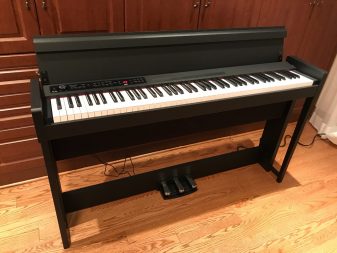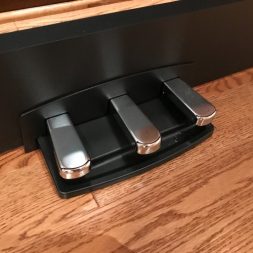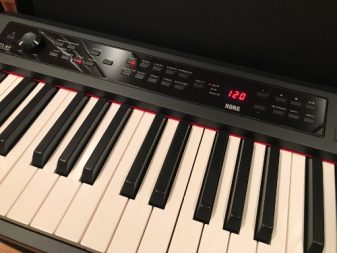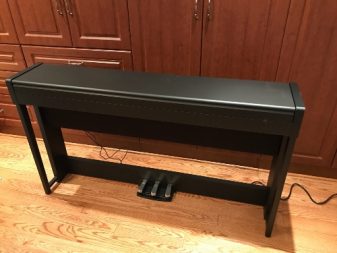
Japanese manufacturer Korg is back with a new digital piano that will surely turn heads: the C1 Air. This fully featured model is housed in a compact, furniture-style stand that’s available in three colours: black, white, and brown. Made in Japan, it delivers high-quality features and tones from a reputable builder. Let’s look at all the features of this easy to assemble instrument.
First of all, make sure you check out this video I made highlighting the C1 Air’s excellent sound quality. I’ve also documented my initial impressions of this model.
Many desirable features
Beautiful design
 Once assembled, you’ll surely be surprised at how compact the C1 Air is. I sure was. It has a minimalist, but solid, design. The legs look really nice and stand out from the regular one-piece plank construction. They support the keyboard part in a very stable manner, even with its shallow depth. The model features 88 weighted keys. Korg’s heavy action is usually very well made, and it’s no exception here. Things feel nice and heavy, as they would on a regular acoustic piano. It progressively gets heavier as you descend in the lower register, and lighter towards the high notes, enhancing the realism even more. Although modern digital pianos seem to favour ivory-style textured keys, the ones here feature a glossy finish.
Once assembled, you’ll surely be surprised at how compact the C1 Air is. I sure was. It has a minimalist, but solid, design. The legs look really nice and stand out from the regular one-piece plank construction. They support the keyboard part in a very stable manner, even with its shallow depth. The model features 88 weighted keys. Korg’s heavy action is usually very well made, and it’s no exception here. Things feel nice and heavy, as they would on a regular acoustic piano. It progressively gets heavier as you descend in the lower register, and lighter towards the high notes, enhancing the realism even more. Although modern digital pianos seem to favour ivory-style textured keys, the ones here feature a glossy finish.
You get a triple pedal unit which presents the regular controls: damper (sustain), sostenuto, and soft. More experienced players will also appreciate the possibility of half-pedaling on this unit, for more control. The speakers (a pair of powerful 25W units) are cleverly housed in the horizontal support board and seem to follow you depending on where you play on the piano.
Large sound selection
 The C1 Air is loaded with high quality sounds: 30 in total. They are easily accessible thanks to a great button layout. They include various piano tones, several electric pianos, harpsichords, a clavinet, vibraphone, marimba, guitar, multiple jazz organs, a few pipe organs, string section choices, and a few combinations of piano & bass. This covers an enormous amount of sonic territory.
The C1 Air is loaded with high quality sounds: 30 in total. They are easily accessible thanks to a great button layout. They include various piano tones, several electric pianos, harpsichords, a clavinet, vibraphone, marimba, guitar, multiple jazz organs, a few pipe organs, string section choices, and a few combinations of piano & bass. This covers an enormous amount of sonic territory.
You can slightly edit these sounds with a couple of effects and a brilliance adjustment. The effects include three levels of reverb and chorus. While you can’t really adjust the nature of these effects, they are well set up by default and will definitely give you the feeling of playing in a larger space, or give your tone more depth.
Several modes
The C1 Air has a few different modes for you to explore. First of all, the layering mode really extends the amount of tones you have at your disposal. This is a function that combines two different sounds. For example, you can combine the lush strings with a nice classical piano to get the impression of being backed by a full orchestra.
You can also split the keyboard into two different tones, having a particular sound on the bass side and another in the higher register. This adds further tonal flexibility to an already versatile platform.
There’s also the partner mode, which is a common feature on many digital pianos. This splits the keyboard into two equal parts, so you can play along with your teacher and really work on the difficult passages of the music you are learning.
Useful connections
 The C1 Air has multiple connections to enhance its versatility. It has not one, but two headphone outputs to enable silent practice—even for duets. It also has a line out to connect to an external speaker system. You can also use this connector to hook up to an audio interface to record the sound of the piano, like I did in the video.
The C1 Air has multiple connections to enhance its versatility. It has not one, but two headphone outputs to enable silent practice—even for duets. It also has a line out to connect to an external speaker system. You can also use this connector to hook up to an audio interface to record the sound of the piano, like I did in the video.
There are MIDI inputs and outputs. This will interest those that have some MIDI gear, as it will enable you to communicate between your devices. This is great for controlling outboard sound banks or other keyboards.
You can also connect Bluetooth devices to use the piano’s great speakers to play back music. This is awesome for simply listening and playing along to your favourite songs or actually using backing tracks in your practice sessions.
Unfortunately, there are no USB connections at all. This feels like an oversight to me, and it’s disappointing. It would’ve been awesome to use this piano to control sound banks on my computer without resorting to the MIDI connections. It would’ve also been great to record this model directly to my computer using USB, as several models on the market can do nowadays. If you are interested in doing either of these things, you will need to invest in an audio interface, if you don’t already have one.
Great sounding package for beginners and experienced players alike
 The Korg C1 Air has some really deep and lush tones. This is a combination of a good sound engine and great speakers. I really enjoyed the various pianos—especially the classical setting, which you hear at the beginning of my video. This is enhanced by a great feeling keyboard. The weight of the keys is just right, and I felt right at home with their glossy finish, having grown up with such a texture myself.
The Korg C1 Air has some really deep and lush tones. This is a combination of a good sound engine and great speakers. I really enjoyed the various pianos—especially the classical setting, which you hear at the beginning of my video. This is enhanced by a great feeling keyboard. The weight of the keys is just right, and I felt right at home with their glossy finish, having grown up with such a texture myself.
For beginners, this is an excellent starting point. Your technique will get all the benefits of a weighted action. A lot of teachers insist on this feature. You will also have all the benefit of having access to a triple pedal unit. Some pianos only feature a sustain pedal. With practice, you will eventually learn to use all of them.

This particular unit will also interest existing players. This is a great model to keep at home, thanks to a great design and compact housing. It might even interest discerning players that want really good action and feel, but who don’t want to deal with the hassle of an acoustic instrument. If you own an audio interface with MIDI inputs, it’s also possible to take this great feeling keyboard and control virtual instruments.
Check out the Korg C1 Air on Best Buy Canada’s website.




Price ?
Great review! Would love to win one for myself to be able to play jingle bells on! <3
No USB port ? No problem! Use the Roland USB MIDI Interface (UM-ONE MK2) , web code 10265566 to set up a link via the MIDI ports on your piano to the USB port on your computer. Allows you to then trigger the sound library on your computer and use this excellent keyboard all day while you compose and create to your hearts content.
Comments are closed.